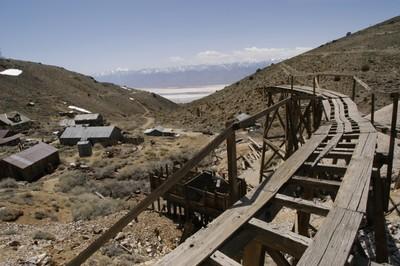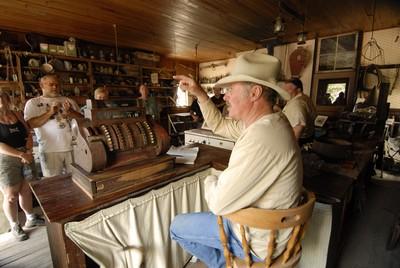CERCA: Spend a night in the 19th Century


It’s a long drive up the Yellow Grade Road to the old ghost town of Cerro Gordo. The seven-and-a-half-mile road climbs about 5,000 feet before reaching its final destination. It’s steeply graded and sometimes rocky, so the going, even in a recommended four-wheel drive, is slow. But the drive is worth it, for at the top of this mountain is the only “bed and cook your own breakfast” ghost town in the world.
The town of Cerro Gordo, located some 30 miles from the western edge of Death Valley National Park, has always been about mining — whether the active pursuit of it or the fierce protection of its history. From the Mexican prospectors who climbed the tall mountain on foot or by mule and scraped its surface in 1864, to present owner Mike Patterson who spent 23 years restoring its buildings and smelters, the inhabitants of this town have always been a determined breed.
Once upon a time Cerro Gordo, now so lonely in its high altitude isolation (Cerro Gordo peak is 9,184 feet, the town itself is at 8,400 feet), fueled the growth of what would become the metropolis of Los Angeles. The rich silver bursting from the fat mountain lured nearly 5,000 people to the burgeoning town in the early 1870s and provided full-time work for dozens of men, merely in freighting heavy bullion to the ports of Los Angeles and San Francisco.
But today, most travelers leaving Death Valley pass by without noticing the unprepossessing sign marking the entrance to the once hotly disputed Yellow Grade Road. In the days when silver smelters belched thick black smoke that filled the thin air above Cerro Gordo night and day, this was a toll road controlled by silver king Mortimer Belshaw. The fee was almost as steep as the grade and all comers paid whether they arrived by foot, by stage or by mule. Up they’d go, to this town that had become a “hideout for cutthroats and thieves” and where men worked themselves ragged for someone else’s riches.
In its isolation, Cerro Gordo had little law enforcement, no churches and no schools. And yet, with its booming population, it was a wild and lively place. Here poorer families lived in shanties clinging to the side of the terraced mountain, while less genteel women worked all night in the dance halls, cribs and brothels. Mules lumbered up and down the mountain constantly hauling that amazing silver, until a complex tramway was built to carry the ore in buckets traveling through the sky.
The town had its array of businesses, from the elegant to the meager. One of the most prominent was the American Hotel, established in 1871. Still standing today, it’s one of Cerro Gordo’s best features and also functions as a social center when large groups come to stay. Guests can sleep in the town’s old bunkhouse and meet for pre-planned meals at the hotel. Today the upstairs rooms are off limits, but on the main floor a wide-open dining room and old-fashioned bar with wood flooring bring the sound and the feel of the Old West to life.
Up the steep hill from the hotel is a museum in the restored hull of Victor Beaudry’s old store. Beaudry, along with Belshaw, struck it rich in Cerro Gordo, making part of his fortune by extending credit to the Mexicans already on the ground when he arrived. He claimed the store in payment for such a debt sometime in the 1860s. Now, however, its shelves are filled not with dry goods but with bits and pieces of the colorful history of this place, including a telephone used to communicate with the men deep down in the mine tunnels, silver bullion molded with the name Cerro Gordo, photographs, china, false teeth — a random sampling of the items that made life a little easier for the thousands of hopefuls who traveled here.
Across the street from the museum, Belshaw’s fine home still stands. Travelers can spend the night here in this house, cook a meal in the (relatively) modernized kitchen, glory in the newfangled working plumbing and sit on the front porch in the quiet stillness of evening. Here one can almost hear the clang of the blacksmith’s hammer in the old shop just down the street, or the steady clomping of horseshoes along the dirt thoroughfare, or the fiddlers tuning up for another long night at Lola’s dance hall near the entrance to the mines.
And here one can survey Belshaw’s former domain, thinking of all the booms that busted up here on this mountain, from the 1870s to the turn of the century, to World War II. In the late 1940s, the town was sold for back taxes to one individual and has remained a private endeavor since. It began its long transformation into today’s unique mix of history and hospitality when a lovely blonde game show hostess named Jody Stewart drove her Porsche straight out of Hollywood and up that mountain. She fell in love with the place and bought it from an aging uncle in 1984. Along the way, Stewart also fell in love with and married a man named Mike Patterson, who has been running the town alone since her untimely death in 2001, from cancer at the age of 57.
Patterson may just be one of the most amazing things about this surprising town. Congenial and encyclopedic in his knowledge of the history, Patterson seems to love this high, hard mountain where he is sometimes buried in snow, deluged by flash floods, or up to his elbows in broken plumbing. But it’s the love of history that maintains him, keeps him working winter after harsh winter, to pursue the stories of Cerro Gordo, to keep the town and its buildings alive, and to make them available to the world at large.
Or at least to anyone with stamina enough to get themselves up that old Yellow Grade Road.












